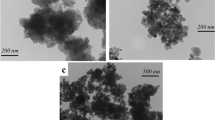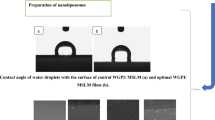Abstract
Biocomposites have gained tremendous advantages over synthetic composites due to their biocompatibility, sustainable degradation, and ability to easily combine with other substances. In the present study, we have prepared silk fibroin (SF) hydrogel, mulberry leaf extract (MLE), tasar pupal oil (TPO), and their composites, such as TPO-loaded SF hydrogel and MLE-loaded SF hydrogel, and characterized them by using a phase contrast microscope (PCM), scanning electron microscope (SEM) SEM- EDX, and Fourier transform infrared spectroscopy (FTIR). In addition, 1H-NMR was used for profiling of mulberry leaf extract and GC–MS was used to find tasar pupal oil composition. Further, the disc diffusion method evaluated their antimicrobial activities against S. aureus, E. coli, A. flavus, and A. brassicae. PCM, SEM, and FTIR results validated the conjugation of MLE and SF hydrogel composite; 1H-NMR confirmed the 41 metabolites in MLE, and GC–MS established the composition of tasar pupal oil. Since both composites, such as TPO-loaded SF hydrogel and MLE-loaded SF hydrogel, reduced the S. aureus and E. coli activities at all tested concentrations, the antibacterial results were unambiguous in their conclusion. S. aureus could only be inhibited by SF hydrogel at a high concentration (300 g/ml), despite suppressing E. coli growth at all tested concentrations. At 300 g/ml, MLE demonstrated antibacterial action against S. aureus. Furthermore, at a dosage of 300 g/ml, TPO inhibited both S. aureus and E. coli. Both mulberry leaf extract (at 200 and 300 g/ml) and the MLE-loaded SF hydrogel composite displayed antifungal activity against A. flavus at all tested concentrations (100, 200, and 300 g/ml).
















Similar content being viewed by others
Data availability
All generated and analysed data during this study are included in this article.
References
Ansary HR, Roy T, Asraf A, Easmin S (2020) Preparation, characterization and antifungal activity studies of AgNPs loaded silk fibroin hydrogels. Am J Nano Res Appl. 8(2):28–34
Asakura T, Okushita K, Williamson MP (2015) Analysis of the structure of Bombyx mori silk fibroin by NMR. Macromolecules 48(8):2345–2357
Asemani M, Rabbani AR (2020) Detailed FTIR spectroscopy characterization of crude oil extracted asphaltenes: curve resolve of overlapping bands. J Petrol Sci Eng 185:106618
Bai H, Wang X, Zhou Y, Zhang L (2012) Preparation and characterization of poly (vinylidene fluoride) composite membranes blended with nano-crystalline cellulose. Progress Nat Sci Mater Int 22(3):250–257
Barth A (2007) Infrared spectroscopy of proteins. Biochimica Et BiophysicaActa (BBA) Bioenergetics 1767(9):1073–1101
Belay B, Koivisto JT, Parraga J et al (2021) Optical projection tomography as a quantitative tool for analysis of cell morphology and density in 3D hydrogels. Sci Rep 11:6538. https://doi.org/10.1038/s41598-021-85996-8
Dev P, Ramappa KV, Gopal R, Sangeeta (2017) Analysis of chemical composition of mulberry silkworm pupal oil with Fourier transform infrared spectroscopy (FTIR), gas chromatography/mass spectrometry (GC/MS) and its antimicrobial property. Asian J Agric Res 11(4):108–115
Devi DR, Battu GR (2019) Qualitative phytochemical screening and FTIR spectroscopic analysis of Grewia tilifolia (vahl) leaf extracts. Int J Curr Pharm Res 11(4):100–107
Diana S, Ana-Maria E, Lorena MA et al (2022) Natural compounds with antimicrobial and antiviral effect and nanocarriers used for their transportation. Front Pharmacol 12:2405
Doron S, Gorbach SL (2008) Bacterial infections: overview. Int Encyc Public Health. https://doi.org/10.1016/B978-012373960-5.00596-7
Dyakonov T, Yang CH, Bush D, Gosangari S, Majuru S, Fatmi A (2012) Design and characterization of a silk-fibroin-based drug delivery platform using naproxen as a model drug. J Drug Deliv 2012:1–10
Ramadan EM et al (2017) Antibacterial, antibiofilm and antitumor activities of grape and mulberry leaves ethanolic extracts towards bacterial clinical strains. Ann Agric Sci 62:151–159
Floren M, Migliaresi C, Motta A (2016) Processing techniques and applications of silk hydrogels in bioengineering. J Funct Biomater 7:26
Haiyan Z, Baoqi Z (2021) Functional silk fibroin hydrogels: preparation properties and applications. J Mater Chem B 9(5):1238–1258. https://doi.org/10.1039/D0TB02099K
Hammond EW (1993) Chromatography for the analysis of lipids. CRC Press, Boca Raton, p 208 (ISBN: 9780849342554)
Hemmalakshmi S, Priyanga S, Devaki K (2017) Fourier transform infra-red spectroscopy analysis of Erythrina variegata L. J Pharm Sci Res 9(11):2062–2067
Huang Y, Zhang B, Xu G, Wentao Hao W (2013) Swelling behaviours and mechanical properties of silk fibroin–polyurethane composite hydrogels. Compos Sci Technol 84:15–22
Jan B, Parveen R, Zahiruddin S, Khan UM, Mahopatra S, Ahmad S (2021) Saudi J Biol Sci. 28(7):3909–3921
Janakiraman N, Johnson M (2015) Functional groups of tree ferns (Cyathea) using FT-IR: chemotaxonomic implications. Rom J Biophys 25:131–141
Jing J, Liang S, Yan Y, Tian X, Li X (2019) Fabrication of hybrid hydrogels from silk fibroin and tannic acid with enhanced gelation and antibacterial activities. ACS Biomater Sci Eng 5:4601–4611
Khameneh B, Iranshahy M, Soheili V (2019) Review on plant antimicrobials: a mechanistic viewpoint. Antimicrob Resist Infect Control 8:118
Kim HM, Park HW (2016) Chemically cross-linked silk fibroin hydrogel with enhanced elastic properties, biodegradability, and biocompatibility. Int J Nanomed 2016(11):2967–2978
Kim U, Park J, Li C et al (2004) Structure and properties of silk hydrogels. Biomacromol 5(3):786–792. https://doi.org/10.1021/bm0345460
Kong J, Yu S (2007) Fourier transform infrared spectroscopic analysis of protein secondary structures. Actabiochimica Et Biophysica Sinica. 39(8):549–559
Król E, Jeszka-Skowron M, Krejpcio Z, Flaczyk E, Wójciak RW (2016) The effects of supplementary mulberry leaf (Morus alba) extracts on the trace element status (Fe, Zn and Cu) in relation to diabetes management and antioxidant indices in diabetic rats. Biol Trace Elem Res 174(1):158–165. https://doi.org/10.1007/s12011-016-0696-1. (Epub Apr 13. PMID: 27071614; PMCID: PMC5055558)
Kumar RV, Srivastava D, Singh V et al (2020a) Characterization, biological evaluation and molecular docking of mulberry fruit pectin. Sci Rep 10:21789. https://doi.org/10.1038/s41598-020-78086-8
Kumar VR, Srivastava D, Kumar U, Kumar M, Singh P (2020b) Bioprospecting of omega 3 fatty acid from silkworm pupal oil: from molecular mechanism to biological activities. J Biol Active Prod Nat 10(6):495–506
Kwon CO, Taek W, Ju K, Bok H, Soon Y, Kim (2019) Antifungal activities of extracts from different parts of mulberry plant against Alternaria alternata and Fusarium sp. Int J Ind Entomol 38(1):6–13
Liu J, Sun H, Peng Y, Chen L, Xu W, Shao R (2022) Preparation and characterization of natural silk fibroin hydrogel for protein drug delivery. Molecules 27:3418
Okaiyeto K, Hoppe H, Okoh AI (2021) Plant-based synthesis of silver nanoparticles using aqueous leaf extract of Salvia officinalis: characterization and its antiplasmodial activity. J Cluster Sci 32(1):101–109
Omidiran MO, Baiyewu RA, Ademola IT (2012) Phytochemical analysis, nutritional composition and antimicrobial activity of white mulberry (Morus alba ). Pak J Nutr 11(5):456–460
Pancu DF, Scurtu A, Macasoi IG et al (2021) Antibiotics: conventional therapy and natural compounds with antibacterial activity—a pharmaco-toxicological screening. Antibiotics 10:401. https://doi.org/10.3390/antibiotics10040401
Pandey P, Mishra A, Pandey J (2022) Effect on immunity and overall tissue health of stinging catfish, Heteropnuestes fossilis (Bloch, 1974) in curcumin medium. Indian J Nutr Dietetics. https://doi.org/10.21048/INJD.2022.59.2.29282.59(2).169-186
Pharmawati M, Wrasiati LP (2020) Phytochemical screening and FTIR spectroscopy on crude extract from Enhalus acoroides leaves. Malays J Anal Sci. 24(1):70–77
Rabai O, Belkhir M, Fattouch AM (2017) Phytochemical for mulberry extract (Morus sp.): antioxidant and neuroprotective potentials. J Appl Pharma Sci 7:217–222
Rai J, Randhawa GK, Kaur M (2013) Recent advances in antibacterial drugs. Int J Appl Basic Med Res 3(1):3–10. https://doi.org/10.4103/2229-516X.112229. (PMID: 23776832; PMCID: PMC3678679)
Rockwood DN, Preda RC, Yücel T, Wang X, Lovett M, Kaplan DL (2013) Materials fabrication from Bombyx mori silk fibroin. NIH-PA Author Manuscript
Roy T, Ansary RH (2021) Fabrication characterization and antifungal activity studies of silk fibroin hydrogel as a potential controlled release of fluconazole. IJACR 1(1):31–38
Sahayaraj AP, Gowri J, Dharmalingam V, Shobana R, Prema AA (2015) Phytochemical screening by FTIR spectroscopic analysis of leaf and stem extracts of Wedelia biflora. Int J Nano Corros Sci Eng. 2(5):322–334
Sim SF, Lee TZE, MohdIrwan L et al (2014) Synchronized analysis of FTIR spectra and GCMS chromatograms for evaluation of the thermally degraded vegetable oils. J Anal Methods Chem 2014:1–9
Sudha C, Ahilan B, Felix N et al (2022) Replacement of fish oil with black soldier fly larvae oil and vegetable oils: Effects of growth, whole-body fatty acid profile, digestive enzyme activity, haemato-biochemical responses and muscle growth-related gene expression of juvenile striped catfish Pangasianodon hypophthalmus. Aquac Res. https://doi.org/10.1111/are.15823
Sun W, Gregory DA, Tomeh MA, Zhao X (2021) Silk fibroin as a functional biomaterial for tissue engineering. Int J Mol Sci 22(3):1499
Tangsanthatkun J, Peanparkdee M, Katekhong W, Harnsilawat T, Tan CP, Klinkesorn U (2022) Application of aqueous saline process to extract silkworm pupae oil (Bombyx mori): process optimization and composition analysis. Foods 11(3):291
Thabti I, Elfalleh W, Hannachi H, Ferchichi A, Campos MDG (2012) Identification and quantification of phenolic acids and flavonol glycosides in Tunisian Morus species by HPLC-DAD and HPLC–MS. J Funct Foods. 4:367–374 (Google Scholar, Ref list)
Thaipitakwong T, Numhom S, Aramwit P (2018) Mulberry leaves and their potential effects against cardiometabolic risks: a review of chemical compositions, biological properties and clinical efficacy. Pharm Biol 56(1):109–118. https://doi.org/10.1080/13880209.2018.1424210. (PMID: 29347857; PMCID: PMC6130672)
Thirupathaiah Y, Sivaprasad V, Bhuvaneswari E et al (2016) Extraction and characterization of mulberry silkworm, Bombyx mori L. pupae oil. Indian J Seric 55(1–2):31–37
Vongsvivut J, Miller MR, McNaughton D, Heraud P, Barrow CJ (2014) Rapid discrimination and determination of polyunsaturated fatty acid composition in marine oils by FTIR spectroscopy and multivariate data analysis. Food Bioprocess Technol 7(8):2410–2422
Wang J, Li Y, Gao Y, Xie Z et al (2018) Cinnamon oil-loaded composite emulsion hydrogels with antibacterial activity prepared using concentrated emulsion templates. Ind Crops Prod 112:281–289
Wilaiwan S, Chirapha B, Yaowalak S, Prasong S (2010) Screening of some elements in different silk cocoon varieties. J Appl Sci 10:575–579. https://doi.org/10.3923/jas.2010.575.579
Yuzhen L, Changwen D, Yanqiu S, Jianmin Z (2014) Characterization of rapeseed oil using FTIR-ATR spectroscopy. J Food Sci Eng 4:244–249
Zuluaga-Velez A, Combita-Merchan FD, Buitrago-Sierra R, Felipe-Santa J, Aguilar-Fernandez E, Sepulveda-Arias CJ (2019) Silk fibroin hydrogels from the Colombian silkworm Bombyx mori L: evaluation of physicochemical properties. PLoS ONE 14:e0213303
Acknowledgements
We acknowledge Professor Sanjay Singh Vice-chancellor of BBAU for his encouragement.
Author information
Authors and Affiliations
Contributions
RVK. was involved in conceptualizing, reviewing and editing, and supervision. VS and DS contributed to the methodology and writing—original draft preparation. DK, AV, DV, EF, and PC contributed to the software, validation, and experiment performed. UK and DK contributed to the software and validation.
Corresponding author
Ethics declarations
Conflict of interest
Regarding the research and publication of this article, the author declares no potential conflicts of interest.
Rights and permissions
Springer Nature or its licensor (e.g. a society or other partner) holds exclusive rights to this article under a publishing agreement with the author(s) or other rightsholder(s); author self-archiving of the accepted manuscript version of this article is solely governed by the terms of such publishing agreement and applicable law.
About this article
Cite this article
Ramappa, V.K., Singh, V., Srivastava, D. et al. Fabrication of mulberry leaf extract (MLE)- and tasar pupal oil (TPO)-loaded silk fibroin (SF) hydrogels and their antimicrobial properties. 3 Biotech 13, 37 (2023). https://doi.org/10.1007/s13205-022-03443-5
Received:
Accepted:
Published:
DOI: https://doi.org/10.1007/s13205-022-03443-5




